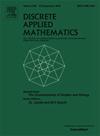On z-coloring and b∗-coloring of graphs as improved variants of the b-coloring
IF 1
3区 数学
Q3 MATHEMATICS, APPLIED
引用次数: 0
Abstract
Let be a simple graph and a proper vertex coloring of . A vertex is called b-vertex in if all colors except appear in the neighborhood of . By a -coloring of using colors we define a proper vertex coloring such that there is a b-vertex (called nice vertex) such that is adjacent to a b-vertex of color for each with . The -chromatic number of , denoted by is the largest integer such that has a -coloring using colors. Every graph admits a -coloring which is an improvement over the famous b-coloring. A z-coloring of is a coloring using colors containing a nice vertex of color such that for each two colors , each vertex of color has a neighbor of color in the graph (i.e. is obtained from a Grundy-coloring of ). We prove that cannot be approximated within any constant factor unless . We obtain results for -coloring and z-coloring of block graphs, cacti, -sparse graphs, pseudo-split graphs and graphs with girth greater than 4. A linear 0-1 programming model is also presented for z-coloring of graphs. The positive results suggest that researches can be focused on -coloring (or z-coloring) instead of b-coloring of graphs.
图的z-着色和b * -着色作为b-着色的改进变体
设G是一个简单图,c是G的一个固有顶点着色,如果除c(u)以外的所有颜色都出现在u的邻域中,则顶点u称为(G,c)中的b顶点。通过使用颜色{1,…,k}对G进行b *着色,我们定义了一个固有顶点着色c,使得对于j≠c(u)的每个j∈{1,…,k},存在一个b顶点u(称为好顶点),使得u与一个颜色为j的b顶点相邻。用b * (G)表示的G的b *色数是使G具有使用k种颜色的b *色的最大整数k。每个图G都有b * -着色,这是对著名的b-着色的改进。G的z-着色是使用颜色{1,2,…,k}的着色c,其中包含一个颜色k的漂亮顶点,使得对于每两个颜色i<;j,颜色j的每个顶点在图中都有一个颜色i的邻居(即c是由G的grundy着色得到的)。证明除非P=NP,否则b * (G)不能在任何常数因子内近似。我们得到了块图、cacti图、p4 -稀疏图、伪分割图和周长大于4的图的b * -着色和z-着色的结果。给出了图z着色的线性0-1规划模型。积极的结果表明,研究可以集中在图的b *着色(或z-着色)上,而不是b-着色。
本文章由计算机程序翻译,如有差异,请以英文原文为准。
求助全文
约1分钟内获得全文
求助全文
来源期刊

Discrete Applied Mathematics
数学-应用数学
CiteScore
2.30
自引率
9.10%
发文量
422
审稿时长
4.5 months
期刊介绍:
The aim of Discrete Applied Mathematics is to bring together research papers in different areas of algorithmic and applicable discrete mathematics as well as applications of combinatorial mathematics to informatics and various areas of science and technology. Contributions presented to the journal can be research papers, short notes, surveys, and possibly research problems. The "Communications" section will be devoted to the fastest possible publication of recent research results that are checked and recommended for publication by a member of the Editorial Board. The journal will also publish a limited number of book announcements as well as proceedings of conferences. These proceedings will be fully refereed and adhere to the normal standards of the journal.
Potential authors are advised to view the journal and the open calls-for-papers of special issues before submitting their manuscripts. Only high-quality, original work that is within the scope of the journal or the targeted special issue will be considered.
 求助内容:
求助内容: 应助结果提醒方式:
应助结果提醒方式:


